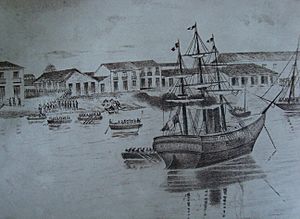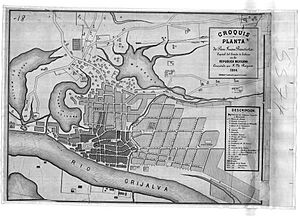Battle of San Juan Bautista facts for kids
The Battle of San Juan Bautista was an important fight during the Second French intervention in Mexico. It happened on February 27, 1864. In this battle, Mexican Republican forces won and took back control of the city of San Juan Bautista.
The Mexican Republican army was mostly made up of local fighters from Tabasco. There were between 300 and 1,100 of them. Interestingly, only about half of these soldiers had proper guns. The rest fought with tools like machetes!
Quick facts for kids Battle of San Juan Bautista |
|||||||
|---|---|---|---|---|---|---|---|
| Part of the Second French intervention in Mexico | |||||||
 French evacuation at San Juan Bautista |
|||||||
|
|||||||
| Belligerents | |||||||
| Commanders and leaders | |||||||
| Eduardo González Arévalo Manuel Diaz de la Vega Gabriel Escoffié Antonio Castillo † |
Gregorio Méndez Andrés Sánchez Magallanes Lino Merino Pedro Fuentes Narciso Sáenz |
||||||
| Units involved | |||||||
| French Navy city garrison Martinican volunteers |
liberal Tabasco Army (see details) |
||||||
| Strength | |||||||
| 700 several ships |
1,100 | ||||||
| Casualties and losses | |||||||
| 4 dead 19 injured |
13 dead 11 injured |
||||||
Contents
Taking Back San Juan Bautista
San Juan Bautista, which was the capital of Tabasco, had been taken over by the Imperialist forces on June 13, 1863. These Imperialist forces were allied with the French.
Starting from December 2, 1863, the Mexican Republican forces began to attack the city from different directions. Small groups of soldiers set up positions around the capital. For example, Lieutenant Juan Morales cut off communication to the city. Commander Narciso Sáenz gathered volunteers from nearby towns. Colonel Lino Merino and Colonel Pedro Fuentes also set up their forces in different areas. From these spots, the Republicans started their attacks on the French in the city.
Early Skirmishes
On January 1, 1864, Pedro Fuentes and a few soldiers bravely rode into a church and rang its bells. This was a way to show defiance to the enemy. After a short fight, they returned safely to their camp. A few days later, on January 3, Fuentes pushed back some French soldiers from a town square.
By January 7, Commander Narciso Sáenz prepared a larger force of 400 foot soldiers and 60 cavalry. They also had a small cannon. They moved closer to the city, settling in Tierra Colorada by January 9. Other Republican leaders, like Lino Merino and Juan Morales, joined their forces in Mazaltepec.
The Siege Begins
On January 14, the Republican army began to surround the city. They moved their troops into different areas to block the French. One group, the Zaragoza section, moved through a forest to attack the French from the side. Other companies joined them to take positions near the French defenses. The main Republican force moved along the National Road, facing the French center. They had three cannons to help them.
Mexican scout cavalry were spotted by the French soldiers at the city gates. The first shots were fired, and two Mexican soldiers were hurt. However, the Mexican cavalry quickly caused trouble for the Imperialist soldiers. Four of their soldiers, including their commander Antonio Castillo, were killed. Nine were taken prisoner.
French Defenses
The Imperialist forces focused their defense around the "Principal" building and the Governor's House in San Juan Bautista. These buildings were strongly fortified with barricades and holes for shooting. They were connected by tunnels that led to Comercio Street. The Republicans, meanwhile, took over a house north of the market that had holes in its walls facing Esquipulas Street.
The French had several lines of defense. The first line was made of buildings and trenches. The second line was also trenches, closer to the river. The final line followed the Grijalva River and other small streams. All these lines were connected by ditches and walls with shooting holes.
The Republican Army completely surrounded the town by January 18. They set up five smaller cannons and two large 24-pounder cannons around San Juan Bautista. The French were dug in along the streets and the coast, protected by their warships. These included two French steam gunships, La Tourmente and La Pique, and several other boats.
Reinforcements and Attacks
The French commander, Eduardo González Arévalo, had about 350 Mexican riflemen and 250 French marines. In the first days of the siege, the Imperialists tried to break out, but they didn't succeed. It's interesting to note that more Imperialist soldiers were wounded by machetes than by gunshots during this time!
On January 19, a new Imperial Governor, Manuel Diaz de la Vega, arrived in San Juan Bautista by boat. His convoy was attacked by 30 Republican soldiers, and some Imperialists were injured. The next day, the new governor asked the Republicans to surrender, offering them safety. The Republicans refused, and a fight broke out. The Republicans pushed back the attack and took 18-20 prisoners.
On February 5, the French garrison received 280 new soldiers from Martinique. A few days later, on February 12, about 50-60 Imperialist soldiers who were retreating from Palenque also found refuge with the governor's forces.
The Final Push
The Republicans slowly advanced, fighting house by house. The French would tear down buildings as they retreated. The Republicans used a large 24-pounder cannon to hit the French ship Tourmente nine times. They even picked up enemy cannonballs from the ground to reuse them!
When the Republicans reached the strong houses and barricades of the French, the French considered giving up the city. On February 11, 1864, the Tabasco forces launched a big attack on "The Principal" building, where many French troops were hiding. The attack lasted over an hour, but the Republicans successfully took over the "Principal."
The "Casa Fuerte" (Strong House) was the last place the French defenders held, right by the river. The Republicans decided to attack it with heavy artillery from a nearby hill. When the French and their Mexican allies saw the heavy shelling, they quickly left the city. They got on their ships and sailed away.
The fleeing soldiers left behind a lot of supplies. This included several cannons of different sizes, many firearms with bayonets, lances, ammunition, grenades, and even five horses. This was a big victory for the Mexican Republicans!
Mexican Order of Battle
This section shows how the Mexican divisions were organized on January 14, 1864.
- First command
- Colonel-in-chief Gregorio Mendez
- Commander Eusebio Castillo
- Colonel Lino Merino
- Lieutenant Colonel Andres Sanchez
- Battalion Commander Pedro Fuentes
- Secretary to Battalion Commander Francisco Vídaña
- Commissioner of war captain Miguel Payan Ortiz
- Assistant to Colonel-in-chief captain Francisco Chapuz
- 1st Center coloumn
- Companies of Cárdenas and Huimanguillo (Francisco Ramírez)
- 2nd Right coloumn
- Zaragoza section (Juan R. de la Rosa)
- 3rd Left coloumn
- Companies of Hidalgo, Valle and Juchitán (Narciso Sáenz)
- 4th Reserves
- "Castillo" section (Cornelio Castillo)
- 5th Artillery (Mateo Pimienta)
- 6th Cavalry (Mariano Alfaro)
See also
 In Spanish: Toma de San Juan Bautista para niños
In Spanish: Toma de San Juan Bautista para niños
- List of battles of the French intervention in Mexico



